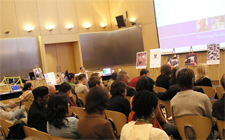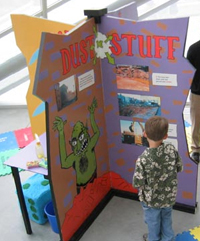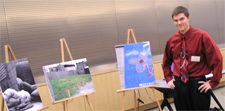The Art of Public Health (web article)
Environmental Justice Partnership Hosts First Annual Art Exhibit
It’s been said that a picture can be worth a thousand words. A number of students from the Maryland Institute College of Art (MICA) have taken this old axiom to heart. They are using carefully crafted images and works of art to translate complex public health research into easily understood messages. Some of their work was on display at a special exhibition hosted by the Environmental Justice Partnership and held at the Johns Hopkins Bloomberg School of Public Health on December 9.

The Environmental Justice
Partnership's First Annual Art Exhibit
was held in Feinstone Hall
The Environmental Justice Partnership was formed in 2003 as a way to promote healthy behavior in the East Baltimore community and to better involve the community in the research conducted at the Bloomberg School. Like many poorer, urban communities, East Baltimore faces a greater burden from environmental health hazards, such as lead paint and air pollution, compared to some wealthier communities. The National Institute for Environmental Health Sciences began funding the Environmental Justice Partnership with the notion that better partnerships and community input could lead to better science and better solutions to environmental problems.
“The language of the [NIEHS] grant contains the words 'environmental justice' deliberately. For us, justice is the opposite of exploitation," said Nancy Kass, PhD, a bioethicist at the Phoebe R. Berman Bioethics Institute and professor of Health Policy and Management at the Johns Hopkins Bloomberg School of Public Health. "It is really important for public health work to further the interests of communities through research and to make sure that research is never exploitive of communities. It needs to be a voice for community priorities and procedures and work collectively with the community,” added Kass, principal investigator of the Environment Justice Partnership, which she oversees with co-investigator Andrea Gielen, ScD, professor in the School’s Department of Health, Behavior and Society.

Exhibit educates parents
and children about the
hazards of lead exposure
The Environmental Justice partnership has also been working closely with the Bloomberg School’s Institutional Review Board, which oversees and approves research activities. The partnership is available as a liaison to School projects that will be conducted in the local East Baltimore community.
“If researchers find something and it’s not disseminated to the community, it’s worthless—especially to the people who need it the most,” said Leon Purnell, executive of the Men’s Center in East Baltimore and chair of the Environmental Justice Partnership Community Board.
For the exhibit, MICA student Andrew Jaborsky displays images from his “Reconnect” campaign—a series of 14 photos meant to represent both the negatives and the positives of East Baltimore. Black and white photos of dirty city streets stand in stark contrast to vibrant images of a vacant lot turned into a flower garden that spells the word “LOVE.” The word “Reconnect” appears on each image, sometimes as a statement and other times as a question. Jaborsky said the campaign is meant to encourage political leaders to address the environmental problems facing East Baltimore.

MICA student Andrew Jaborsky
displays images from his
"Reconnect" campaign
Over the past several years, the MICA team has been involved in developing several successful projects, including the Dash Diet campaign to promote health eating and hypertension management among African Americans and an exhibit to inform parents and children about hazards of lead exposure. They’ve also designed artwork, computer animation and displays for the Johns Hopkins CARES Mobile Safety Center, a virtual house-on-wheels designed to educate parents about injury prevention. The team applied its artistic skills to communicate research and public health messages in a manner that is informative and culturally sensitive.
“I would say for most of the students that take on this project, it changes their lives,” said Bernard Canniffe, chair of the Graphic Design Department at MICA. “With advertising or graphic design, we are sort of used to encouraging people to buy things they don’t really need. [With this project] we are taking the same sort of skill set and they are trying to change behavior or change community or change people’s lives. It’s beautiful. They're like 'Yes, I can see this happening--for the common good.'”--Tim Parsons
For more information about the Environmental Justice Partnership, contact Clara Goldberg-Freeman, MHS, CHES, at 410-502-4137 or cgoldber@jhsph.edu.